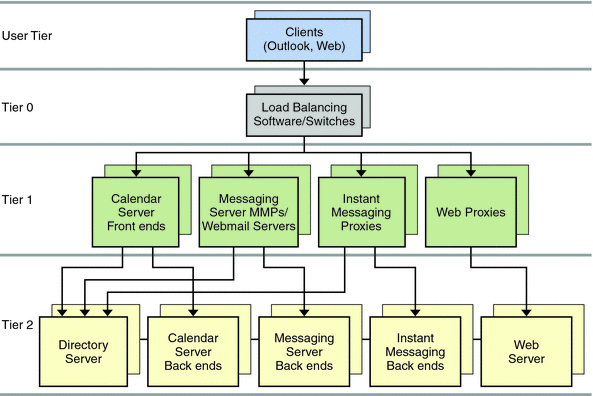Two-tiered Logical Architecture
In a two-tiered logical architecture, the data stores communicate through front-end processes. In the case of Messaging Server, this means MMPs and MTAs are residing on separate machines from the data store processes. A two-tiered architecture enables the mail store to offload important and common tasks and focus on receiving and delivering mail. In the case of Calendar Server, this means the HTTP service and Administration service reside on a separate machine from the store processes. In the case of Instant Messaging, this means the proxy service is residing on a separate machine from the back-end processes.
There might be some level of cohabitation with other services. For example, you could have the Calendar store and the Message Store on the same machine. Similarly, you could have the calendar front end on the MMP machine.
In a two-tiered logical architecture, Directory Server is usually a complex deployment in its own right, with multi-master and replication to a set of load-balanced consumer directories.
Figure 5–4 represents the two-tiered logical architecture.
Figure 5–4 Two-tiered Architecture

In the preceding figure, end-user client programs, such as Outlook and Messenger Express, form the User Tier. The load balancers form Tier 0. The Calendar Server, Messaging Server, Instant Messaging, and web proxy front ends form Tier 1. Finally, the Directory Server, Calendar Server, Messaging Server, and Instant Messaging back ends form Tier 2. When deploying Communications Express, you could have Web Server in Tier 2 as well.
A two-tiered architecture enables you to deploy Tier 1 and Tier 2 elements as separate instances, increasing overall flexibility of design. Additionally, you enhance system security by assigning discrete functions to individual instances.
For typical deployments, place the messaging and calendar front ends within the network Demilitarized Zone (DMZ), connecting to the main messaging and calendar services through a firewall. This configuration enables you to scale the system horizontally, as the Tier 1 elements can be scaled independently. Do not scale these elements beyond the capacity of the back-end servers.
When the front-end elements have reached the capacity of the back-end servers, you can scale the back-end Tier 2 elements to support more users. In general, the front end should scale as a function of the traffic. The back end should be scaled as a function of the number of users.
Note –
For specific instructions on sizing components in single-tiered or two-tiered architectures, contact your Client Services representative.
- © 2010, Oracle Corporation and/or its affiliates
